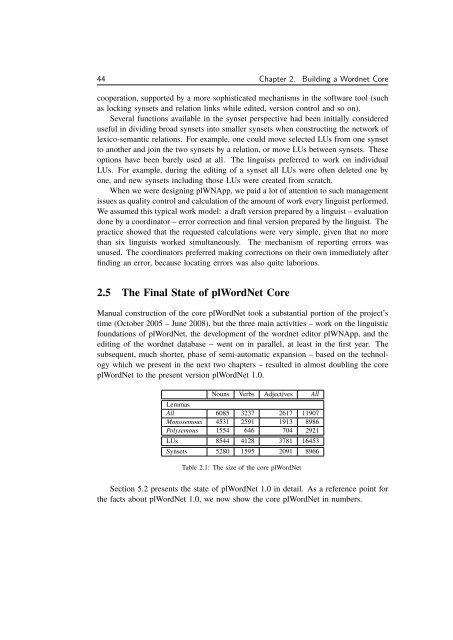A Wordnet from the Ground Up
A Wordnet from the Ground Up - School of Information Technology ...
A Wordnet from the Ground Up - School of Information Technology ...
You also want an ePaper? Increase the reach of your titles
YUMPU automatically turns print PDFs into web optimized ePapers that Google loves.
44 Chapter 2. Building a <strong>Wordnet</strong> Corecooperation, supported by a more sophisticated mechanisms in <strong>the</strong> software tool (suchas locking synsets and relation links while edited, version control and so on).Several functions available in <strong>the</strong> synset perspective had been initially considereduseful in dividing broad synsets into smaller synsets when constructing <strong>the</strong> network oflexico-semantic relations. For example, one could move selected LUs <strong>from</strong> one synsetto ano<strong>the</strong>r and join <strong>the</strong> two synsets by a relation, or move LUs between synsets. Theseoptions have been barely used at all. The linguists preferred to work on individualLUs. For example, during <strong>the</strong> editing of a synset all LUs were often deleted one byone, and new synsets including those LUs were created <strong>from</strong> scratch.When we were designing plWNApp, we paid a lot of attention to such managementissues as quality control and calculation of <strong>the</strong> amount of work every linguist performed.We assumed this typical work model: a draft version prepared by a linguist – evaluationdone by a coordinator – error correction and final version prepared by <strong>the</strong> linguist. Thepractice showed that <strong>the</strong> requested calculations were very simple, given that no morethan six linguists worked simultaneously. The mechanism of reporting errors wasunused. The coordinators preferred making corrections on <strong>the</strong>ir own immediately afterfinding an error, because locating errors was also quite laborious.2.5 The Final State of plWordNet CoreManual construction of <strong>the</strong> core plWordNet took a substantial portion of <strong>the</strong> project’stime (October 2005 – June 2008), but <strong>the</strong> three main activities – work on <strong>the</strong> linguisticfoundations of plWordNet, <strong>the</strong> development of <strong>the</strong> wordnet editor plWNApp, and <strong>the</strong>editing of <strong>the</strong> wordnet database – went on in parallel, at least in <strong>the</strong> first year. Thesubsequent, much shorter, phase of semi-automatic expansion – based on <strong>the</strong> technologywhich we present in <strong>the</strong> next two chapters – resulted in almost doubling <strong>the</strong> coreplWordNet to <strong>the</strong> present version plWordNet 1.0.Nouns Verbs Adjectives AllLemmasAll 6085 3237 2617 11907Monosemous 4531 2591 1913 8986Polysemous 1554 646 704 2921LUs 8544 4128 3781 16453Synsets 5280 1595 2091 8966Table 2.1: The size of <strong>the</strong> core plWordNetSection 5.2 presents <strong>the</strong> state of plWordNet 1.0 in detail. As a reference point for<strong>the</strong> facts about plWordNet 1.0, we now show <strong>the</strong> core plWordNet in numbers.



